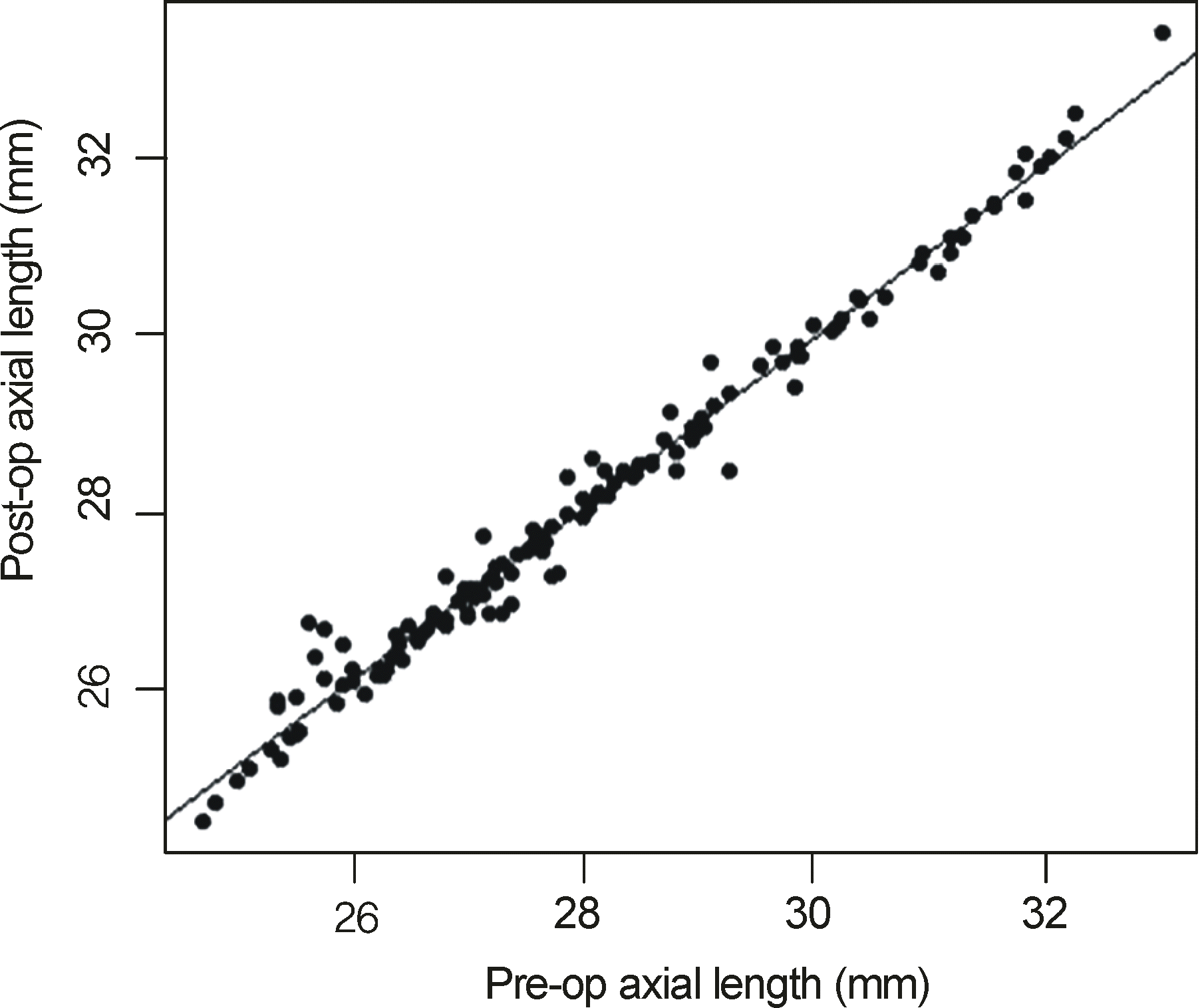Abstract
Purpose
The axial length measurement is an important variable in calculating the intraocular lens (IOL) power in cataract surgery. In this study, the effects of the implantable collamer lens (ICL) on the axial length measurement were investigated.
Methods
The axial lengths of 141 eyes of 76 highly myopic patients were measured before ICL implantation and 1 month postoperatively using applanation A-scan ultrasound.
Results
The measured axial lengths before ICL implantation and 1 month after the surgery were 28.03 ± 1.91 mm and 28.08 ± 1.86 mm respectively, with a statistically significant difference of 0.05 mm (p = 0.036). These 2 values showed a high correlation (R2 = 0.9829, p < 0.0001).
Conclusions
Even though the axial length after ICL implantation significantly increased, the 0.05 mm change was too small to influence the determination of the IOL diopters in cataract surgery. Therefore, ICL implantation history may be reflected when measuring the axial length for the IOL power calculation in cataract surgery, but the axial length measured immediately before the cataract surgery may be used to calculate the IOL power regardless of the ICL implantation history.
References
1. Jeon S, Kim HS. Clinical characteristics and outcomes of cataract surgery in highly myopic Koreans. Korean J Ophthalmol. 2011; 25:84–9.

2. Kubo E, Kumamoto Y, Tsuzuki S, Akagi Y. Axial length, myopia, and the severity of lens opacity at the time of cataract surgery. Arch Ophthalmol. 2006; 124:1586–90.

3. Praveen MR, Shah GD, Vasavada AR, et al. A study to explore the risk factors for the early onset of cataract in India. Eye (Lond). 2010; 24:686–94.

4. Tuft SJ, Bunce C. Axial length and age at cataract surgery. J Cataract Refract Surg. 2004; 30:1045–8.

5. Younan C, Mitchell P, Cumming RG, et al. Myopia and incident cataract and cataract surgery: the blue mountains eye study. Invest Ophthalmol Vis Sci. 2002; 43:3625–32.
6. Fernandes P, González-Méijome JM, Madrid-Costa D, et al. Implantable collamer posterior chamber intraocular lenses: a re- view of potential complications. J Refract Surg. 2011; 27:765–76.
7. Sanders DR. Anterior subcapsular opacities and cataracts 5 years after surgery in the visian implantable collamer lens FDA trial. J Refract Surg. 2008; 24:566–70.

8. Sanders DR, Doney K, Poco M. United States Food and Drug Administration clinical trial of the Implantable Collamer Lens (ICL) for moderate to high myopia: three-year follow-up. Ophthalmology. 2004; 111:1683–92.
9. Sanders DR, Vukich JA, Doney K, Gaston M. U.S. Food and Drug Administration clinical trial of the Implantable Contact Lens for moderate to high myopia. Ophthalmology. 2003; 110:255–66.

10. Jimenez-Alfaro I, Benítez del Castillo JM, García-Feijoó J, et al. Safety of posterior chamber phakic intraocular lenses for the cor- rection of high myopia: anterior segment changes after posterior chamber phakic intraocular lens implantation. Ophthalmology. 2001; 108:90–9.
11. Pérez-Santonja JJ, Iradier MT, Benítez del Castillo JM, et al. Chronic subclinical inflammation in phakic eyes with intraocular lenses to correct myopia. J Cataract Refract Surg. 1996; 22:183–7.

12. Kawamorita T, Uozato H, Shimizu K. Fluid dynamics simulation of aqueous humour in a posterior-chamber phakic intraocular lens with a central perforation. Graefes Arch Clin Exp Ophthalmol. 2012; 250:935–9.

13. Uozato H, Shimizu K, Kawamorita T, Ohmoto F. Modulation transfer function of intraocular collamer lens with a central artifi- cial hole. Graefes Arch Clin Exp Ophthalmol. 2011; 249:1081–5.
14. Harocopos GJ, Shui YB, McKinnon M, et al. Importance of vitre- ous liquefaction in age-related cataract. Invest Ophthalmol Vis Sci. 2004; 45:77–85.
15. Saka N, Moriyama M, Shimada N, et al. Changes of axial length measured by IOL master during 2 years in eyes of adults with pathologic myopia. Graefes Arch Clin Exp Ophthalmol. 2013; 251:495–9.
16. Takahashi A, Ito Y, Iguchi Y, et al. Axial length increases and re- lated changes in highly myopic normal eyes with myopic compli- cations in fellow eyes. Retina. 2012; 32:127–33.
17. Hoffer KJ. Ultrasound axial length measurement in biphakic eyes. J Cataract Refract Surg. 2003; 29:961–5.

18. Sanders DR, Bernitsky DA, Harton PJ Jr, Rivera RR. The Visian myopic implantable collamer lens does not significantly affect ax- ial length measurement with the IOLMaster. J Refract Surg. 2008; 24:957–9.
19. Khokhar SK, Agarwal T. Dave V! Comparison of preoperative and postoperative axial length measurement with immersion A-scan in ICL cases. J Cataract Refract Surg. 2009; 35:2168–9.
20. Retzlaff JA, Sanders DR, Kraff M. Lens implant power calcu- lation: a manual for Ophthalmologists & Biometrists. 3rd ed.Thorofare, NJ: SLACK Incorporated;1990.
Figure 1.
Relation between preoperative axial length (x-axis) and postoperative axial length (y-axis) (y = 0.9665x + 0.9844, R2 = 0.9829, p < 0.0001).

Table 1.
Demographics of patients and preoperative and postoperative characteristics
| Demographics | |||
|---|---|---|---|
| Age (years) | 29.9 ± 7.6 (range; 19-49) | ||
| Sex (Female/Male) (eyes) | 54 (101) / 22 (40) |
| Pre-op. | Post-op. | p-value* | |
|---|---|---|---|
| Axial Length (mm) | 28.03 ± 1.91 | 28.08 ± 1.86 | 0.036 |
| Spherical Equivalent (D) | −12.61 ± 4.34 | −0.93 ± 0.95 | <0.0001 |
| BCVA (log MAR) | 0.06 ± 0.21 | −0.03 ± 0.18 | <0.0001 |




 PDF
PDF ePub
ePub Citation
Citation Print
Print


 XML Download
XML Download